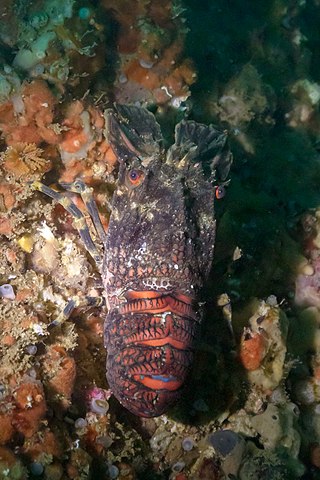
Slipper lobsters are a family (Scyllaridae) of about 90 species of achelate crustaceans, in the Decapoda clade Reptantia, found in all warm oceans and seas. They are not true lobsters, but are more closely related to spiny lobsters and furry lobsters. Slipper lobsters are instantly recognisable by their enlarged antennae, which project forward from the head as wide plates. All the species of slipper lobsters are edible, and some, such as the Moreton Bay bug and the Balmain bug are of commercial importance.

Metanephrops challengeri is a species of slim, pink lobster that lives around the coast of New Zealand. It is typically 13–18 cm (5–7 in) long and weighs around 100 g (3.5 oz). The carapace and abdomen are smooth, and adults are white with pink and brown markings and a conspicuous pair of long, slim claws. M. challengeri lives in burrows at depths of 140–640 m (460–2,100 ft) in a variety of sediments. Although individuals can live for up to 15 years, the species shows low fecundity, where small numbers of larvae hatch at an advanced stage.

Metanephrops japonicus is a species of lobster found in Japanese waters, and a gourmet food in Japanese cuisine. It occurs from Chōshi, Chiba Prefecture (Honshu) to the east coast of Kyushu, where it lives at depths of 200–440 metres (660–1,440 ft). Adults grow to a total length of 9–12 centimetres (3.5–4.7 in), and a carapace length of 3–7 cm (1.2–2.8 in).
Metanephrops boschmai, known as the Bight lobster, Bight scampi or Boschma's scampi, is a species of lobster endemic to Western Australia.

Palinurus elephas is a commonly caught species of spiny lobster from the East Atlantic Ocean and the Mediterranean Sea. Its common names include European spiny lobster, crayfish or cray, crawfish, common spiny lobster, Mediterranean lobster and red lobster.

Panulirus versicolor is a species of spiny lobster that lives in tropical reefs in the Indo-Pacific. Other names include painted lobster, common rock lobster, bamboo lobster, blue lobster, and blue spiny lobster. P. versicolor is one of the three most common varieties of spiny lobster in Sri Lanka, alongside Panulirus homarus and Panulirus ornatus.

Scyllarus arctus is a species of slipper lobster which lives in the Mediterranean Sea and eastern Atlantic Ocean. It is uncommon in British and Irish waters, but a number of English-language vernacular names have been applied, including small European locust lobster, lesser slipper lobster and broad lobster.

Sagmariasus verreauxi is a species of spiny lobster that lives around northern New Zealand, the Kermadec Islands the Chatham Islands and Australia from Queensland to Tasmania. It is probably the longest decapod crustacean in the world, alongside the American lobster Homarus americanus, growing to lengths of up to 60 centimetres (24 in).

Nephropsis rosea, sometimes called the rosy lobsterette or two-toned lobsterette, is a species of lobster.

Scyllarides latus, the Mediterranean slipper lobster, is a species of slipper lobster found in the Mediterranean Sea and in the eastern Atlantic Ocean. It is edible and highly regarded as food, but is now rare over much of its range due to overfishing. Adults may grow to 1 foot (30 cm) long, are camouflaged, and have no claws. They are nocturnal, emerging from caves and other shelters during the night to feed on molluscs. As well as being eaten by humans, S. latus is also preyed upon by a variety of bony fish. Its closest relative is S. herklotsii, which occurs off the Atlantic coast of West Africa; other species of Scyllarides occur in the western Atlantic Ocean and the Indo-Pacific. The larvae and young animals are largely unknown.

Scyllarides is a genus of slipper lobsters.
Eunephrops manningi, the banded lobster, is a species of lobster found in the West Indies. It was named in 1974 by carcinologist Lipke Holthuis after his friend and fellow carcinologist Raymond B. Manning.

Scyllarides aequinoctialis is a species of slipper lobster that lives in the western Atlantic Ocean from South Carolina to São Paulo State, Brazil, including the Gulf of Mexico, Caribbean Sea, and Bermuda. Its common name is Spanish slipper lobster. It grows up to 30 centimetres (12 in) long, with a carapace 12 cm (4.7 in) long. S. aequinoctialis is the type species of the genus Scyllarides and the first species of slipper lobster to be described from the Western Atlantic.

Panulirus pascuensis is a species of spiny lobster found around Easter Island and the Pitcairn Islands in the Pacific Ocean. It is known in English as the Easter Island spiny lobster, Langosta de Isla de Pascua in Spanish and Ura in the Rapa Nui language. This lobster is fished on a small scale for local consumption.

Palinurus mauritanicus is a species of spiny lobster. It is found in deep waters in the eastern Atlantic Ocean and the western Mediterranean Sea.
Eunephrops cadenasi, sometimes called the sculptured lobster, is a species of lobster found in the Caribbean.
Nephropides caribaeus is a species of lobster, the only species in the genus Nephropides. It is found in western parts of the Caribbean Sea, from Belize to Colombia. It grows to a total length of around 170 mm (6.7 in), and is covered in conspicuous tubercles.

Panulirus penicillatus is a species of spiny lobster that lives on shallow rocky and coral reefs in the tropical Indo-Pacific region. Common names for this spiny lobster include variegated crayfish, tufted spiny lobster, spiny lobster, Socorro spiny lobster, red lobster, pronghorn spiny lobster, golden rock lobster, double spined rock lobster and coral cray. It has a very wide range and the International Union for Conservation of Nature has assessed its conservation status as being of "least concern".
Scyllarides haanii, the Aesop slipper lobster, is a marine decapod crustean in the family Scyllaridae. Other common names include the humpbacked slipper lobster and the ridgeback slipper lobster.
Jan Adrianus Herklots was a Dutch zoologist whose main areas of research were carcinology and the echinoderms.












